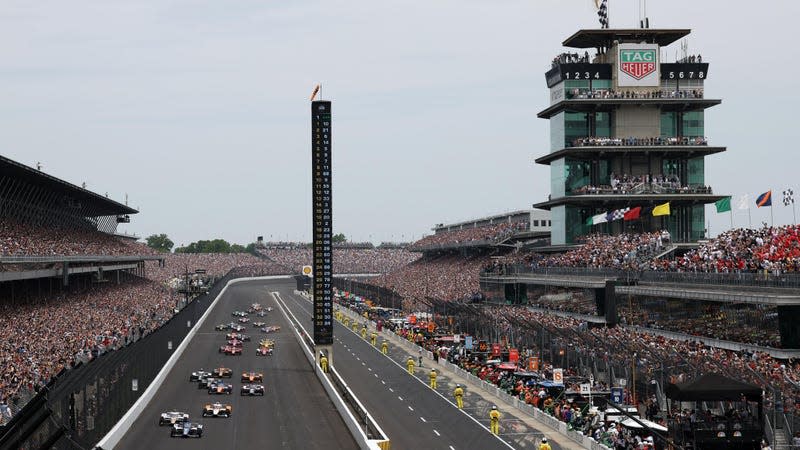The 2023 Indy 500 Finish Set A Nasty Precedent For Oval Racing

The century-long history of the Indianapolis 500 is littered with controversy, but the final quarter of the race’s 2023 running featured three red flags and enough drama to sustain a year’s worth of discourse. More crucially, it set a nasty precedent for future runnings of the event — one that could get drivers seriously hurt in their pursuit of glory.
On lap 184, Felix Rosenqvist slid wide and crashed into the wall after struggling in the wake of Josef Newgarden passing him. Rosenqvist collected Kyle Kirkwood, resulting in the Andretti car flipping upside down and Kirkwood’s tire flying into the parking lot. The incident brought out a red flag to clean the track — but cautions breed cautions, and when racing resumed on lap 192, Pato O’Ward spun and hit the wall after trying to pass Marcus Ericsson. Several other cars collided down the field, and the race was red-flagged again in an effort to finish under green.
Read more
When the race restarted for the second time on lap 196, five cars collided at the start, bringing out the third and final red flag. In order to finish under green, drivers didn’t undergo the normal slew of pace laps under yellow and instead were sent out for one final bout of racing on lap 200. Josef Newgarden was able to pass leader Ericsson, securing a win for Team Penske.
I also want to note that my issue here is not one of distaste over the winner, or one of conspiracy. The finish of the race was chaotic from a sanctioning standpoint, but Team Penske’s Josef Newgarden won the race as it was run. It was a legitimate finish that crowned a legitimate winner — and I really don’t think there’s any funny business afoot, with Roger Penske somehow manipulating the finish to favor one of his drivers.
Instead, my concern is that motorsport in general has been plagued by a desire to generate entertainment at the cost of consistency and safety — something that Ericsson himself noted.
“It was not enough laps to do it,” he said after the race. “I know we want to have a green-flag finish, and that’s great for the fans. It’s fantastic. But the way that crash [on the previous restart] happened, it was not enough laps to do what we did, in my opinion.”
(It’s worth noting that Ericsson lauded the controversial finish of the 2023 Abu Dhabi Grand Prix in Formula 1.)
The problem isn’t really the legality of the finish. IndyCar’s rulebook allows for that one-lap sprint. Instead, the big issue is safety. While a sport like Formula 1 can get away with that one-lap sprint to victory from a safety standpoint, that should never be assumed to be the case with oval racing — especially with open-wheel cars. Oval tracks have served as the location for countless driver deaths in American open-wheel racing, with four transpiring since the turn of the century. A mad dash to the finish on a road course is one thing; it’s something else entirely when it happens on an oval.
Choosing to push the field to a green-flag finish also flies in the face of consistency. In 2020, Spencer Pigot crashed with just five laps left in the 500. The field paced the 2.5-mile track under a yellow flag to complete the traditional distance, but IndyCar deemed it would have been irresponsible to red-flag the race, repair the track, and go green again.
“IndyCar makes every effort to end races under green, but in this case following the assessment of the incident, there were too few laps remaining to gather the field behind the pace car, issue a red flag and then restart for a green-flag finish,” the series said at the time. In 2020, “too few laps” was defined as a one-lap green-flag shootout for the finish — something that happened two years later, when IndyCar forced a green-flag restart before the traditional warm-up pace laps had been completed under yellow.
Formula 1's 2021 Abu Dhabi Grand Prix season finale will forever live in infamy thanks to the race stewards’ desire to prioritize an entertaining finish over one that would have more consistently aligned with prior interpretations of the rules. NASCAR has been regularly criticized for implementing the concept of “overtime” in an effort to force a compelling green-flag finish. In those two cases, the result is largely a poor taste in the mouths of fans around the world.
But IndyCar should be wary of falling victim to the same entertainment-over-everything trap, especially on its ovals. A field full of cars shod in cold tires and run by drivers willing to risk it all for a shot at winning the biggest race in the world needs to be regulated by level-headed stewards. Prioritizing entertainment over safety and consistency will only get someone hurt — or worse.
More from Jalopnik
Sign up for Jalopnik's Newsletter. For the latest news, Facebook, Twitter and Instagram.

 Yahoo Autos
Yahoo Autos 